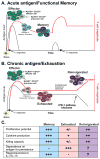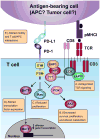Overcoming T cell exhaustion in infection and cancer
- PMID: 25797516
- PMCID: PMC4393798
- DOI: 10.1016/j.it.2015.02.008
Overcoming T cell exhaustion in infection and cancer
Abstract
Inhibitors of the Programmed Cell Death 1: Programmed Cell Death 1 ligand 1 (PD-1:PD-L1) pathway, a central regulator of T cell exhaustion, have been recently shown to be effective for treatment of different cancers. However, clinical responses are mixed, highlighting the need to better understand the mechanisms of action of PD-1:PD-L1, the role of this pathway in immunity to different tumors, and the molecular and cellular effects of PD-1 blockade. Here, we review the molecular regulation of T cell exhaustion, placing recent findings on PD-1 blockade therapies in cancer in the context of the broader understanding of the roles of the PD-1:PD-L1 pathway in T cell exhaustion during chronic infection. We discuss the current understanding of the mechanisms involved in reversing T cell exhaustion, and outline critical areas of focus for future research, both basic and clinical.
Keywords: PD-1; PD-L1; T cell exhaustion; cancer; chronic infection; immunotherapy.
Copyright © 2015 Elsevier Ltd. All rights reserved.
Figures



Similar articles
-
Current state of anti-PD-L1 and anti-PD-1 agents in cancer therapy.Mol Immunol. 2015 Oct;67(2 Pt A):4-17. doi: 10.1016/j.molimm.2015.02.009. Epub 2015 Mar 5. Mol Immunol. 2015. PMID: 25749122 Review.
-
Programmed death-1 & its ligands: promising targets for cancer immunotherapy.Immunotherapy. 2015;7(7):777-92. doi: 10.2217/imt.15.49. Epub 2015 Aug 7. Immunotherapy. 2015. PMID: 26250412 Review.
-
Upregulation of PD-L1 by EGFR Activation Mediates the Immune Escape in EGFR-Driven NSCLC: Implication for Optional Immune Targeted Therapy for NSCLC Patients with EGFR Mutation.J Thorac Oncol. 2015 Jun;10(6):910-23. doi: 10.1097/JTO.0000000000000500. J Thorac Oncol. 2015. PMID: 25658629
-
Primary and acquired resistance to PD-1/PD-L1 blockade in cancer treatment.Int Immunopharmacol. 2017 May;46:210-219. doi: 10.1016/j.intimp.2017.03.015. Epub 2017 Mar 18. Int Immunopharmacol. 2017. PMID: 28324831 Review.
-
Anti-programmed death-1 and anti-programmed death-ligand 1 antibodies in cancer therapy.Expert Opin Biol Ther. 2013 Jun;13(6):847-61. doi: 10.1517/14712598.2013.770836. Epub 2013 Feb 19. Expert Opin Biol Ther. 2013. PMID: 23421934 Review.
Cited by
-
Inflammatory signals are sufficient to elicit TOX expression in mouse and human CD8+ T cells.JCI Insight. 2021 Jul 8;6(13):e150744. doi: 10.1172/jci.insight.150744. JCI Insight. 2021. PMID: 34032638 Free PMC article.
-
Identification of immunological subtypes of hepatocellular carcinoma with expression profiling of immune-modulating genes.Aging (Albany NY). 2020 Jun 16;12(12):12187-12205. doi: 10.18632/aging.103395. Epub 2020 Jun 16. Aging (Albany NY). 2020. PMID: 32544882 Free PMC article.
-
Immune-Based Approaches for the Treatment of Pediatric Malignancies.Annu Rev Cancer Biol. 2020 Mar;4:353-370. doi: 10.1146/annurev-cancerbio-030419-033436. Annu Rev Cancer Biol. 2020. PMID: 34113750 Free PMC article.
-
Immunotherapy for ALK-Rearranged Non-Small Cell Lung Cancer: Challenges Inform Promising Approaches.Cancers (Basel). 2021 Mar 23;13(6):1476. doi: 10.3390/cancers13061476. Cancers (Basel). 2021. PMID: 33806977 Free PMC article. Review.
-
Intertumoral Genetic Heterogeneity Generates Distinct Tumor Microenvironments in a Novel Murine Synchronous Melanoma Model.Cancers (Basel). 2021 May 11;13(10):2293. doi: 10.3390/cancers13102293. Cancers (Basel). 2021. PMID: 34064795 Free PMC article.
References
Publication types
MeSH terms
Substances
Grants and funding
LinkOut - more resources
Full Text Sources
Other Literature Sources
Medical
Research Materials

